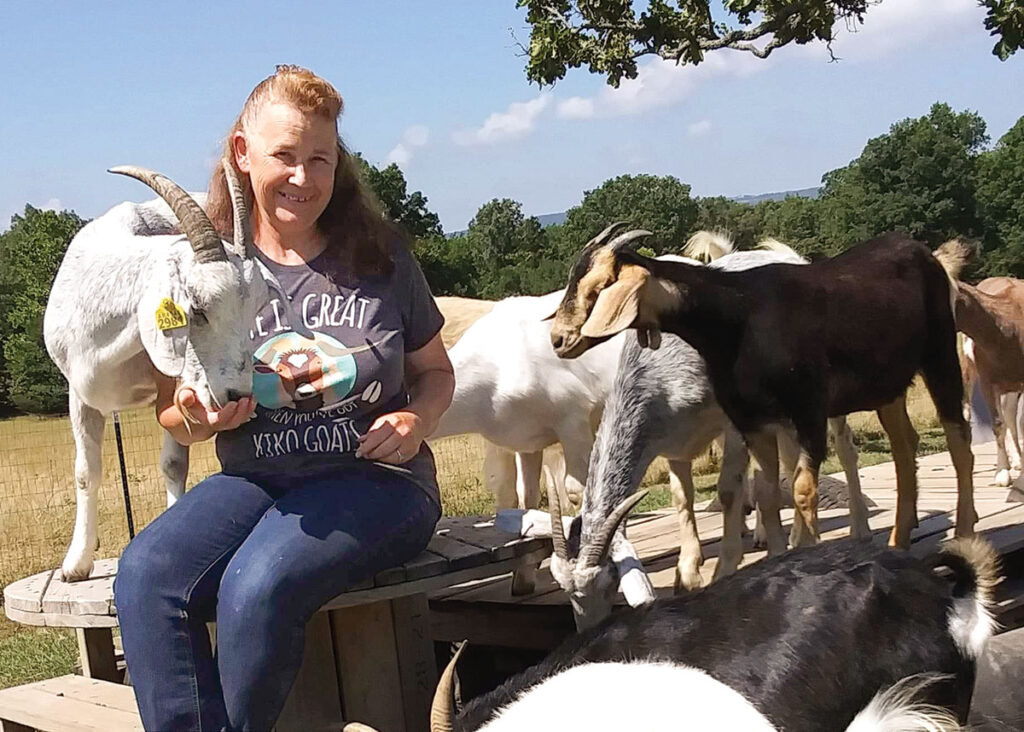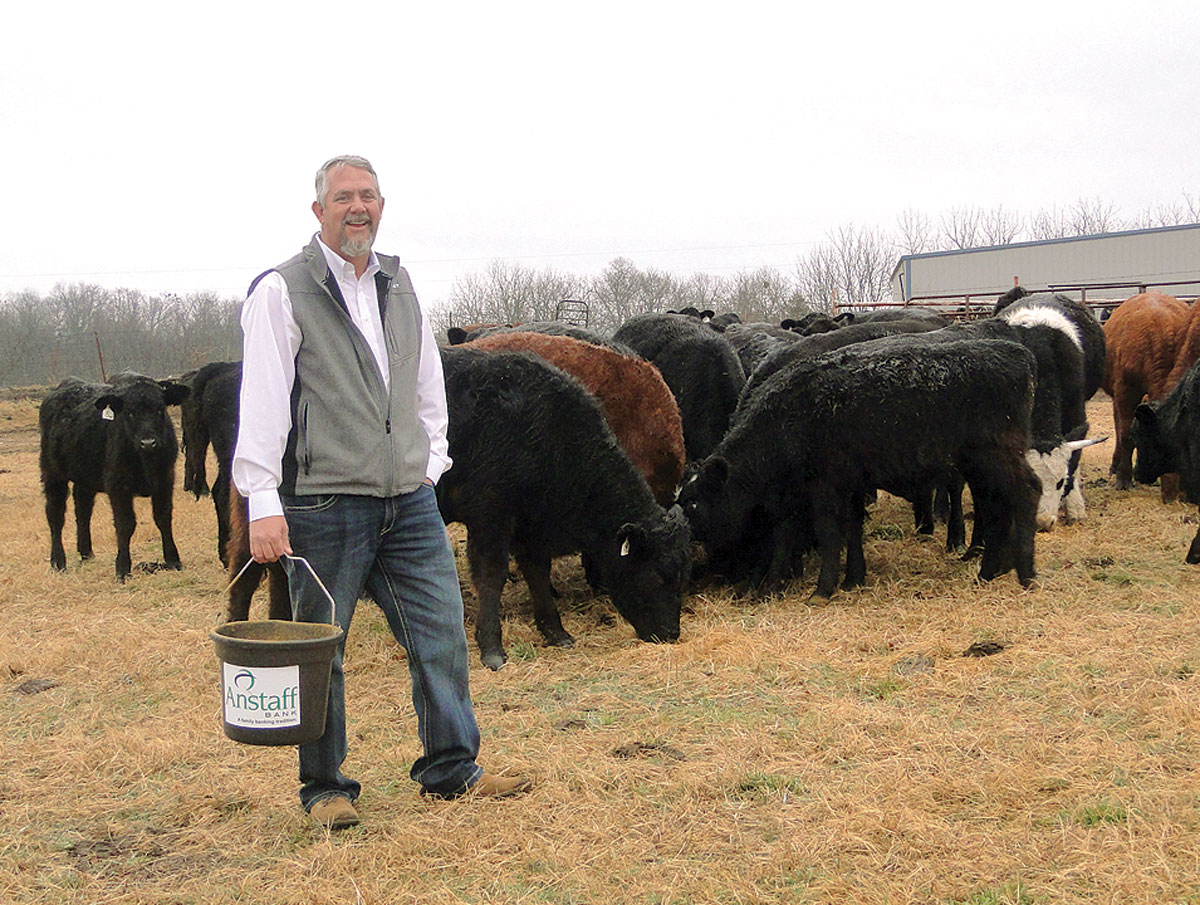
Gynna Southerland says switching from horses to meat goats was the perfect option
BATESVILLE, ARK. – For more than four decades, Gynna Southerland could have been called the horse whisperer. Living in Texas, she raised Quarter horses and other breeds for 40 years.
However, eight years ago, Southerland and her husband Timothy relocated from the Lone Star state to Arkansas and quickly found that a horse ranch was not going to be sustainable.
“We decided that the market wasn’t beneficial for horses,” Gynna said. “I was getting up in age and had been hurt.”
While horses were no longer in her future, Gynna wasn’t ready to give up the ranch life she had lived almost her entire adult life. That’s when she started researching other animals to breed and landed on goats.
“So I did about six months’ worth of research on goats,” Gynna said. ‘I have always liked goats. It led me into the Kikos.”
Southerland looked through every type of goat on the market, but it was the little-known Kiko that stood out to her as the best path forward.
“The goat market is booming in the state of Arkansas,” Gynna said. “We got in it at a really good time. There were very few Kiko breeders; there are four now.”
With its origins hailing from New Zealand, the Kiko goat was bred to grow fast and function as a high-production meat goat. They have become a popular breed due to their hardiness, low maintenance and ability to live in extreme conditions, such as the Ozarks.
“The Kiko and the Spanish both are parasite resistant, they have great feet, they’re great mothers,” Gynna said. “So, there is very little input. When you are going into your 60s and you have a bad back, bad knees and you’re primarily doing the farm by yourself, having an animal that requires less maintenance, and they are now going for more than $4 a pound, that is just smart money.”
Gynna pointed out there is a lot more work and money involved with raising cows compared to goats.
Gynna and Timothy have owned their 22-acre property for eight years. But Gynna didn’t start breeding Kiko goats until four years ago when creating the Southern 22 Kikos Ranch.
When Gynna began breeding goats, her stock included a New Zealand buck, a purebred buck, two purebred does and three commercial does with Boer in them.
The size of her flock can fluctuate depending on the time of the year.
“Because of the way I rotate my pasture, I try to keep no more than 15 does,” Gynna said. “Because goat math is a real thing. Those 15 does in a week can turn into 30 to 45. I know because we’ve had it happen.”
Gynna’s newest herd hails from Washington state. It is comprised of Kikos and Spanish breeds.
“The does I have coming from Lookout Point is an original breeder of the breeds,” Gynna said. “So I am getting really old stock, I’m getting stuff that has been on 500 acres that have never been dewormed, vaccinated, nothing. New blood lines for this area. We have some old Spanish lines coming in. And we’re going to mix a few of our Kikos that are dairy crosses, that we’re going to mix with the Spanish. Because you are not losing anything when you cross that. But you have slighter cheaper milk for people who want to buy something that is rugged and youth.”
Gynna knows the exact origins of every goat that roams her farm. This enables her to make sure and educate her customers and not sell them inferior stock.
“We try to keep a variety of animals, we try to rotate bloodlines. So when people do come back, they can buy safely and not worry that it’s going to be inbred,” Gynna said. “That is one of the nice things about having a papered animal. You know where it’s come from. I know what bloodlines certain people have. So not to sell you this one if you’ve got that one.”
Gynna said the hardest part in raising Kikos is learning what to feed them.
“The goat market is booming in the state of arkansas. we got in it at a really good time. There were very few kiko breeders.”
— Gynna Southerland
“We have native grasses here. I finally found someone who did legume Sericea Lespedeza,” she explained. “We found out Sericea Lespedeza is a huge benefit for goats. The fewer chemicals that you put into your animals, the better your animals are. Especially for a meat animal. That means fewer chemicals in the meat that you eating or the milk.”
According to Gynna, legume Sericea Lespedeza is good for goats in general.
“It’s considered invasive but is great for preventing soil erosion and puts nitrogen in the soil,” Gynna said. “And it’s drought-resistant.”
Gynna takes the health of her stock extremely seriously. She says she won’t feed her goats anything they don’t need.
That includes going not feeding her Kikos goat pellets. Instead Gynna uses horse pellets because she won’t feed them any chemicals they do not need.
Gynna typically weans goat kids at 3 months and they can gain up to half a pound day.
Gynna said university studies have proven that at the ideal butcher weight 65 to 85 pound Kikos have more meat per weight than Boers.
“Not all Kikos are created equal. We’re trying to improve upon what we like. We like a larger doe. Some people like a 90- to a 100-pound doe. I happen to like my meat goats 120-165 pound does,” Gynna said. “I don’t feed them that much, I just feed them correctly. That was the hardest part, finding out for this area; the right minerals, the right balance of the hay and pasture I was feeding them. It’s a learning experience. It’s an ever-evolving learning experience.”
Bucks weigh around 275 pounds while does average around 125 pounds.
While Gynna’s main reason for raising goats was less work, that didn’t mean she wouldn’t have any chores to do.
“With any farm life, there are always chores to do,” she said. “We were doing it without a tractor. We built every stitch of fence and built all of our barns and shelters. My goats lived in a bigger house than I did.”
According to Gynna, Arkansas still has a way to go before they catch up to Oklahoma and Virginia, which she said are the central figures in the goat market. Yet, she believes they made the right decisions in growing the Southern 22 Kikos Goats Ranch.
“It was smart for us. It was a good investment,” Gynna said. “I make the goats pay for themselves. So if I sell a goat, I can buy another goat. Or we use it to buy feed or something for the barn. It always goes right back into the goats. I wanted something that even if we never sold registered stock or seedstock, even if we sold just for meat, they would still pay for themselves or at least pay for feed. We ended up selling more seedstock, so that allowed us to buy better seedstock. So, we just keep improving. Just like with any other business. You always strive to improve.”







